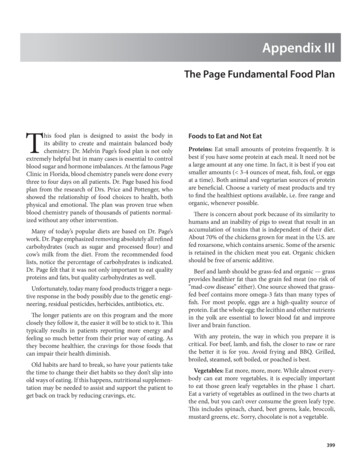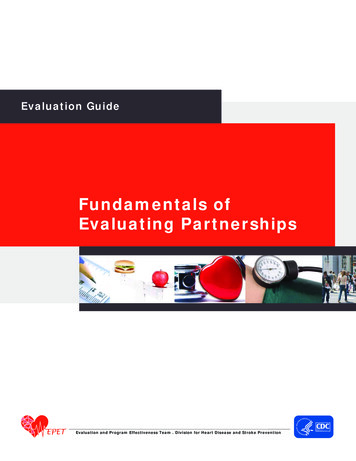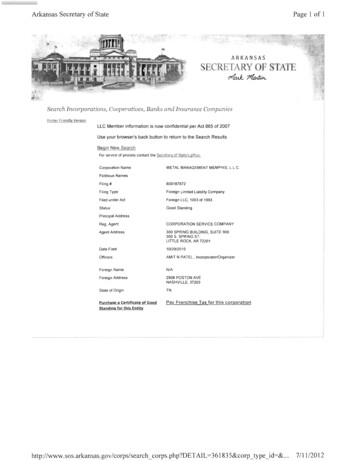
Transcription
Appendix IIIThe Page Fundamental Food PlanThis food plan is designed to assist the body inits ability to create and maintain balanced bodychemistry. Dr. Melvin Page’s food plan is not onlyextremely helpful but in many cases is essential to controlblood sugar and hormone imbalances. At the famous PageClinic in Florida, blood chemistry panels were done everythree to four days on all patients. Dr. Page based his foodplan from the research of Drs. Price and Pottenger, whoshowed the relationship of food choices to health, bothphysical and emotional. The plan was proven true whenblood chemistry panels of thousands of patients normalized without any other intervention.Many of today’s popular diets are based on Dr. Page’swork. Dr. Page emphasized removing absolutely all refinedcarbohydrates (such as sugar and processed flour) andcow’s milk from the diet. From the recommended foodlists, notice the percentage of carbohydrates is indicated.Dr. Page felt that it was not only important to eat qualityproteins and fats, but quality carbohydrates as well.Unfortunately, today many food products trigger a negative response in the body possibly due to the genetic engineering, residual pesticides, herbicides, antibiotics, etc.The longer patients are on this program and the moreclosely they follow it, the easier it will be to stick to it. Thistypically results in patients reporting more energy andfeeling so much better from their prior way of eating. Asthey become healthier, the cravings for those foods thatcan impair their health diminish.Old habits are hard to break, so have your patients takethe time to change their diet habits so they don’t slip intoold ways of eating. If this happens, nutritional supplementation may be needed to assist and support the patient toget back on track by reducing cravings, etc.Foods to Eat and Not EatProteins: Eat small amounts of proteins frequently. It isbest if you have some protein at each meal. It need not bea large amount at any one time. In fact, it is best if you eatsmaller amounts ( 3-4 ounces of meat, fish, foul, or eggsat a time). Both animal and vegetarian sources of proteinare beneficial. Choose a variety of meat products and tryto find the healthiest options available, i.e. free range andorganic, whenever possible.There is concern about pork because of its similarity tohumans and an inability of pigs to sweat that result in anaccumulation of toxins that is independent of their diet.About 70% of the chickens grown for meat in the U.S. arefed roxarsone, which contains arsenic. Some of the arsenicis retained in the chicken meat you eat. Organic chickenshould be free of arsenic additive.Beef and lamb should be grass-fed and organic — grassprovides healthier fat than the grain fed meat (no risk of“mad-cow disease” either). One source showed that grassfed beef contains more omega-3 fats than many types offish. For most people, eggs are a high-quality source ofprotein. Eat the whole egg; the lecithin and other nutrientsin the yolk are essential to lower blood fat and improveliver and brain function.With any protein, the way in which you prepare it iscritical. For beef, lamb, and fish, the closer to raw or rarethe better it is for you. Avoid frying and BBQ. Grilled,broiled, steamed, soft boiled, or poached is best.Vegetables: Eat more, more, more. While almost everybody can eat more vegetables, it is especially importantto eat those green leafy vegetables in the phase 1 chart.Eat a variety of vegetables as outlined in the two charts atthe end, but you can’t over consume the green leafy type.This includes spinach, chard, beet greens, kale, broccoli,mustard greens, etc. Sorry, chocolate is not a vegetable.399
Laboratory Interpretations — Desk Reference ManualAs above, the quality of your produce (fresh and organicpreferred), and the method of preparation are important.The vegetables should be the vegetables that are in season.Raw is not always preferred and lightly steamed or sautéedmay be a better choice for many vegetables.Dr. Page originally recommended sautéing only inbutter or olive oil. Although, there is now a wider selection of cold pressed oils available such as grape seed oil,avocado oil and coconut oil the evidence of benefit seemsto still favor of butter and olive oil. Use lettuces with arich green color, sprouts and raw nuts for salads. Iceberglettuce is one of the least nutritious types. Don’t makesalads the only choice for vegetables. Substitute nuts andseeds for croutons.Remember vegetables receive their nutrients from thewater and soil they’re growing in. Corporate farmingtechniques have replaced quantity over quality. That’s whysome commercially-grown tomatoes look like cardboardinside and have 5 to 0 mg of vitamin C, whereas the original seed stock in healthy soil can have 125 to 250 mg ofvitamin C per tomato.While drinking vegetable juice does sound healthy,chewing is important. Chewing activates part of the brainthat controls appetite and prepares the GI tract for digestion. Wheat grass and the “green food” products shouldalso be mentioned. For many people who are depletedin nutrients, these seem to provide a lift. However, largeamounts of green foods can be irritating to your colon andshould be used sparingly as well. Man does not appear tobe designed to be a grass-eater. Trying to outsmart naturewith “super foods” or a blender may not only be ignorantbut arrogant as well.Fruits: In addition to the advantages with chewing food,the more important reason not to drink fruit juice is thatit is loaded with fructose, which is forced into forming triglycerides and ultimately stored as fat. Without the fiberin the fruit, juice sends a rapid burst of fructose into theblood stream.a symptom of an imbalance; use this craving as a monitoring of biochemical and hormonal balance.Overall, vegetables should be the carbohydrate choiceand grains (even the whole grains) should be minimizedor avoided. Eat whole grains only in moderation and onlyat dinner. Research suggests that starting the day withcarbohydrates, increases the likelihood of craving themthroughout the day. Absolutely stay away from breads(100% rye only bread is the least of the evils), muffins,cookies, candies, crackers, pastas, white rice and mostbaked goods.Carbohydrate intake, like excess calorie intake from anysource, stimulates insulin release, which has been foundto be directly connected to fat gain, inflammation, insulinresistance and diabetes, elevated cholesterol and triglycerides, and cancer.Although we tend to focus on insulin’s role in lowering blood glucose, insulin’s fundamental purpose is tostore energy at times of excess. In other words, insulin isreleased when the supply of food is greater than the need,and then insulin acts to store the extra calories as fat, etc.for potential use later. It is an excellent adaptation whenthe food supply is inconsistent. However, we are fortunateto have more than enough calories available, but we consistently eat far more than we need. As a result of excessintake, nature following its laws, releases insulin and storesthe energy (mostly as fat).Studies indicate that some of the dietary factors promoting insulin resistance, weight gain, and diabetes includerefined carbohydrates such as sugar, products made withwhite flour, white rice, etc., cooked animal fats, trans-fattyacids, pasteurized dairy products, and caffeine. Ways toimprove insulin sensitivity in general include exercise anda low-calorie diet that is also low in refined/processedsimple carbohydrates and rich in vegetables.Other recommendations include eating only one typeof fruit at a time on an empty stomach; avoid sweet fruits(like very ripe bananas and the tropical fruits); and eatonly fresh and organic northern fruits listed in the Phase2 Page Food Plan guidelines when possible. Wild berriesare a good choice for fruit intake.Grains: There has been a tremendous amount of debateregarding grains. Whole unprocessed grains can be richsources of vitamins and minerals, but with soil depletionand the special strains of grain that modern agriculturehas developed, it isn’t clear what nutrients remain. Whenscholars study disease patterns and the decline of variouscivilizations, many of the degenerative diseases developed when cultivation of grains became a major part oftheir diet.Carbohydrates: This is a very tricky area. Most peopleclassify carbohydrates as either complex or simple/processed. Unfortunately for most patients suffering withimbalance problems, almost any carbohydrate is problematic. It is a physiological fact that the more carbohydratesyou eat, the more you will want. Craving carbohydrates isAllergic reactions, chemicals naturally found in certaingrains, lack of the appropriate enzymes, and the carbohydrate content of grains make them a source of trouble formany individuals. My opinion at this time is to minimizegrains. Unprocessed rye, rolled oats and brown rice canbe considered on occasion to give more variety and fiber.400
Appendix III — The Page Fundamental Food PlanSome of the Scandinavian and European brown breads,like pumpernickel, seem to be highly nutritious. Sproutingor soaking grain in water overnight seems to alter its character to a more valuable, and probably safer, nutrient.Sweeteners: If you cheat, be smart. Use only a smallamount of raw Tupelo or Makuna honey. Absolutely noNutra-Sweet, corn syrup, high fructose syrups, or tablesugar. Although Dr. Page did not allow raw cane sugar, itdoes provide the nutrients to aid in its metabolism. Useonly raw cane sugar (called Succanat or Sugar In The Raw in the brown bags) in small amounts and only with a meal.Saccharin and Sucralose in small quantities are the lesserof the sugar-free evils, but the “need for sweet” suggeststhat there is an imbalance in your biochemistry.Aspartame and Stevia create more problems thanthey solve because they stimulate sweet receptors on thetongue, which in turn stimulates brain receptors for anticipation of sweet. When it does not arrive, sweet cravingoccurs to satisfy what the brain expected to receive. It isno wonder that studies show that more calories are consumed by those who use artificial sweeteners than thosewho consume whole foods that are naturally sweet.Remember a man in his natural state consumed less than1 pound a year and now most research shows us consuming over 140 pounds a year.Fats: You may be surprised that most Americans areactually deficient in fat — specifically essential fatty acids,which include fat-soluble “vitamins.” Olive oil (coldpressed, extra virgin), walnut oil, flaxseed, sesame, andavocado oil are generally beneficial for individuals withanaerobic tendencies (discussed in Chapter 2). Cookonly with raw organic butter, sesame oil, olive oil andcoconut oil. Avoid all hydrogenated and partially-hydrogenated oils; margarine, crackers, chips, fried foods, etc.They are poisons. Because peanut butter, even if raw andwithout the typical hydrogenation oils, is 28% carbohydrate, use peanuts and peanut butter sparingly. Avocados,raw nuts and seeds can typically be consumed with somerestrictions.It is a common misconception that eating fat will makeyou fat. Ingested fats stimulate a signal to the brain to slowdown stomach peristalsis and gastric emptying. Satietyis the result. It is not surprising that recent research isshowing that those who eat “fat-free” products tend toactually consume more calories than those who eat foodsthat have not had their fat content reduced or tamperedwith. In addition, it is often overlooked that fats are usednot only for energy but also for cellular membranes,formation of many hormones, etc. It is far worse to behormone depleted from a low-fat diet than it is to overeatfats. The sickest patients are often those who have beenon a fat-free diet for a long time. As with carbohydrates,choose fats wisely — Dr. Page never recommended friedor processed foods.Milk Products: Dr. Page found that pasteurized cow’smilk products (cheese, sour cream, half & half, ice cream,cottage cheese, yogurt, etc.) are actually more detrimental than sugar for many people. Avoiding dairy productsmade it much easier for them to attain optimal biochemical and hormonal balance. Raw butter, on the other hand,is an excellent source of essential nutrients and vitamins.Because fat is a repository for lipid-soluble chemicals,toxins, and hormones, grass-fed, organic butter is a must.Raw goat’s or sheep milk products are better alternativesbecause their genetic code and fat content is apparentlymore like those of humans. Be cautious however.There has been a lot of advertising about using soy,almond, coconut, and rice milk to replace dairy milk.While they sound like healthy alternatives, they really arehighly-processed foods that are primarily simple carbohydrates. Of course, Vitamite, Mocha Mix, and the otherdairy substitutes are highly-processed nutrient-depletedproducts and so should not be considered food.Liquids: Water is the only substance that qualifies as anideal liquid. Many diseases can be explained on the basisof dehydration. It should be considered the first and largestpart of almost all food plans. Traditionally, the minimumnumber of ounces of water to be consumed daily is onehalf body weight in pounds.Water should be consumed in small amounts throughout the day rather than in large glasses sporadically. Allwater should be chlorine and fluoride free. Spring waterseems to be best for most people’s needs. Tap water, evenwhen purified by charcoal and reverse osmosis, is oftennot as pure as it should be and can be imbalanced ordepleted in terms of mineral content. Nevertheless, it ismore important to consume water of even modest qualitythan it is to substitute it for other liquids.Avoid plastic containers — the evidence of safety hasnot been proven and higher than ideal levels of manychemicals in the urine of the majority of patients routinelyusing plastics in food and liquid preparation and storagehas been observed.Avoid all soda, especially those with artificial sweeteners; Organic coffee in moderation if the metabolism tolerates it. Medium roasts have more anti-oxidant effect thandark roasts. For every cup of coffee, drink an extra equivalent amount of water since coffee is a diuretic. Fruit juicesare forbidden because of their high fructose content anddumping of sugar into the blood stream. An occasional401
Laboratory Interpretations — Desk Reference Manualsmall glass of vegetable juice with a meal is probablyacceptable.blood sugar results. Eating a small balanced meal will stopthis cycle.The most important life-giving substance in the bodyis water. The average adult body is 65% water. Even withno activity the body is estimated to lose a minimum of sixglasses a day. With movement, exercise, and sugar intake,etc. the requirement can be more than 15 glasses of watera day. Consider this; the concentration of water in theadult brain has been estimated to be 85% and the watercontent of the liver, kidney, muscle, heart, intestines, etc.is 75% water. An adult’s water content is about 60-70% ofthe total lean body weight.Eating smaller meals also has advantages for yourimmune response to ingested food. It is known that asmall amount of food can enters the blood without firstgoing through the normal digestive pathways. As a result,this food is seen by the body not as nourishment but asa threat that stimulates an immune reaction. Normally, asmall immune reaction is not even noticed, but if a largeamount of food (or if a food is eaten over and over again),the immune reaction can cause symptoms. Over time,disease can develops.Netter’s Atlas of Human Physiology reports that about2/3 of the body’s water is inside the cells (intracellular)and 1/3 is outside of the cells (extracellular). To keep thatbalance, water wants to move from the outside of the cell(where it is diluted) into the cell (where it is more concentrated) to provide osmotic balance. The urge water has tomove is called hydroelectric power (also part of the transmembrane potential). That’s the same electrical powergenerated at hydroelectric dams (like Hoover Dam). Theenergy made in your body is in part hydroelectric.By eating smaller amounts, the size of the reaction thatoccurs is small and hopefully inconsequential. A largemeal, and thus a large assault of the immune system, couldcause many symptoms of an activated immune systemincluding fatigue, joint aches, flu-like symptoms, headaches, etc. This reaction was called the metabolic rejectivity syndrome by the late nutritional pioneer, Arthur L.Kaslow, MD. He recommended five “mini-meals” consumed throughout the day in his book Freedom FromChronic Disease. Using thousands of his patients’ fooddiaries, he compiled a list of high-risk foods that is muchthe same as Dr. Page’s. Dairy and wheat products were atthe top of both lists of troublesome foods.For those who enjoy wine or beer, there are some guidelines. First, drink only with meals. Red wine has less sugarand more of the beneficial polyphenols than white wines.Real beer is actually brewed/fermented and contains farmore nutrients than the pasteurized chemicals called beermade by the large commercial breweries in the UnitedStates. Less is better. Occasional, rather than regularis better. Hard liquors should be completely avoided.Because alcohol, like coffee, force water loss, more waterwill be needed to compensate.Eat Smaller Amounts More FrequentlyEating smaller amounts reduces the energetic stress ofdigestion. In other words, eating small meals conservesenergy and avoids overwhelming it when you eat a largemeal. Incomplete digestion promotes indigestion, yeastovergrowth, gas, inflammation, food reactions, etc.Another reason for eating smaller meals is to preventblood sugar level swings and sugar cravings. Since thebody will not (or should not) allow the blood sugar levelto rise excessively, insulin and other hormones are whenthe blood glucose rises above about 84 mg%. Often times,the insulin response is too strong and within a short, timeinsulin has driven the blood sugar level down. As a resultof the now low blood sugar, a powerful craving for sugaror other carbohydrates develops. This promotes compensatory overeating, and the cycle of up-and-down, yo-yo402Eating five smaller meals is not always practical. A small(healthy) snack between the main meals of the day maysuffice. Some individuals report “once I start eating, I can’tstop.” These individuals will most likely require additionalhelp with nutritional supplementation, at least initially.The new Time Restrictive Feeding plan (TRF) and TheFasting Mimicking Diet (FMD) both restrict food intaketo 8 to 12 hours maximum. Both of these food plans recommend to you eat your prominent meal in the morningor noon and eat lightly in the evening. The phase 1 part ofthe Page Food Plan is almost identical but where these twopopular plans fail is in the transition of the patient into ahealthy diet and lifestyle, the Page phase 2 maintenanceplan is excellent for the transition.SupplementationIn reviewing the many diets used all over the world, thereare pros and cons to each. For example, a vegetariandiet tends to minimize tissue inflammation but may notsupport tissue rejuvenation if there is a lack of completeprotein and fats found primarily in animal products. Themajor concern with the Page program is that most peopledo not eat enough vegetables and therefore do not get adequate amounts of usable minerals and vitamins. Since the
Appendix III — The Page Fundamental Food Planfats and proteins tend to promote acid production in thebody, it is very important to get enough alkalizing minerals to buffer the acid load. For this reason, mineral supplements specific to the patient needs should be taken.Final Note: The Page Food Plan was designed foroptimal health, helping tens of thousands of Dr. Page’spatients, many of whom lived well into their later yearswithout signs of degenerative diseases such as heartdisease, arthritis, cancer, osteoporosis, etc. The Page FoodPlan is not intended to be a sacrifice, in fact quite theopposite. Balancing the body chemistry enables optimalphysical, mental, and emotional function.The Influence of Blood TypeAs mentioned earlier, avoiding those food lectins associated with your blood type is worth a try A — avoid dairy products, mangoes, oranges, potatoes,tomatoes, and papaya.B — avoid chicken, buckwheat, and peanuts.O — avoid wheat and corn.The Page Food Plan is designed to balance body chemistry regardless of ethnic background or blood type. Thephase 1 plan will tend to detoxify and rebalance bodychemistry. As a result of the Page Food Plan, one willquickly realize that the intake of protein necessarily goesup. This has raised concerns about over-consumption ofprotein and its effect on osteoporosis, etc. A study of 3600Britons over a seven-year period showed no correlationbetween meat consumption and cancer. Fresh fruits andvegetables intake as expected had a protective effect (BMJ.1997;315(7114):1018). The Page Food Plan emphasizesvegetables as the dominant portion of the diet. Most of thesupportive evidence in prospective studies for an association between consumption of meat and colorectal cancercomes from the United States rather than Europe (NutrRes Rev. 1996;9:197-239). The way in which the meat israised or cooked in the relationship of meat consumptionto vegetables and fruit in the average diet might explainthe inconsistent findings.Nevertheless, there are positive associations with certaintypes of cancer with meat consumption. More with redmeats, rather than white meat, seem to be associated withelevated risk of colon cancer. In breast cancer, there areconsistent associations with total meat intake and there isevidence of overconsumption having a response. Despitethese associations with meat, existing studies suggest thatvegetarians do not have reduced risk of breast, bowel orprostate cancer.Possible mechanisms underlying epidemiological associations include the formation of heterocyclic amines inmeat when it is cooked. These heterocyclic amines requireacetylation by P450 enzymes, and individuals with thefast-acetylating genotype who eat high amounts of meatmay be at increased risk of colon cancer. Ammonia andN-nitroso compounds (NOC) formed from residuesby bacteria in the colon and may also be important.Ammonia is a promoter of large-bowel tumors that arechemically induced by NOC, and some of the chromosomal mutations found in human colorectal cancer areconsistent with effects of NOC and heterocyclic amines(Proc Nutr Soc. 1999;58(2):243-8). With greater accessto determining genetic make-up, perhaps we will findout what one person’s meat is another’s poison. Fornow, grass-fed meat in moderation and of course, lots ofgreen vegetables.The other concern with increased protein intake hasbeen with promoting osteoporosis due to the systemicacidification that results from protein metabolism. Thefour-year Framingham Osteoporosis Study found thatof the 615 adults (average age 75 years) with the lowestprotein intake and lowest animal protein had significantlyincreased rates of bone loss in the femur and spine compared to those with higher protein intakes (J Bone MinRes. 2000;15(12):2504-12).Another study in Switzerland showed the same findings— higher protein intake was associated with greater bonedensity. A Chinese study of elderly females found lowerbone mineral densities in vegetarians than in omnivores.There was no difference between the lacto vegetarians andthe vegetarians with regard to bone mineral density.This brings us to one of Dr. Page’s observations that thebiggest advantage for a patient starting a vegetarian diet isthey usually stop eating the foods that made them sick inthe first place.403
Laboratory Interpretations — Desk Reference ManualPhase I Diet Plan for Balancing Body ChemistryLEAN MEATFISHFOWLEGGSVEGETABLESNo Limit on Serving Size of Vegetables use the chart below for protein, Grass fed, Free Range orOrganic when possible (No pork). Phase 1 is a cleansing and detoxifying program to be used for 2 to 3weeks, can be used for weight loss as well.VEGETABLES3% or less carbsAsparagusBamboo ShootsBean SproutsBeet GreensBok Choy yCollard ucesMushroomsMustard GreensParsleyRadishesRaw Cob CornSalad GreensSauerkrautSpinachString BeansSummer SquashesTurnip GreensWatercressYellow SquashZucchini SquashVEGETABLES6% or less carbsBell PeppersBok Choy StemsChivesEggplantGreen BeansGreen OnionsOkraOlivesPicklesPimentoRhubarbSweet PotatoesTomatoesWater ChestnutsYamsVEGETABLES7 - 9% carbsAcorn SquashArtichokesAvocadoBeetsBrussel SproutsButternut psWinter SquashesMISCELLANEOUSIn Limited AmountsButter, RawDressing - Oil / Cider Vinegar onlyOils – Olive, Flax oils or Vegetable, (noCanola) preferably cold- Pressed.JerkyCaviarNuts, Raw (except Peanuts)Beef TeaBouillon – Beef, ChickenHerbal (Decaffeinated) TeasFiltered or Spring WaterEach of your meals must include some protein. The easiest sources are meat, fish, poultry,or eggs. (Count 2 eggs as equal to 3 oz). Vegetarians must combine proteins carefully andconsistently using a different calculation! An easy way to calculate the amount of protein youneed is to divide your ideal body weight by 15 to get the number of ounces of protein to beconsumed per day. This is not a "high protein diet." Like many people, you already eat thismuch protein during a day, but you eat it mostly in 1 or 2 meals instead of spreading it outevenly over 5 meals. If you are more physically active, eat more protein.This chart is predominantly for weight loss90 lb. IBW 6 ounces a day or 1-1½ ounces of protein at each of five meals.105 lb. IBW 7 ounces a day or 1½-1¾ ounces of protein at each of five meals.120 lb. IBW 8 ounces a day or 1¾-2 ounces of protein at each of five meals135 lb. IBW 9 ounces a day or 2-2¼ ounces of protein at each of five meals.150 lb. IBW 10 ounces a day or 2-2¼ ounces of protein at each of five meals.165 lb. IBW 11 ounces a day or 2¼-2½ ounces of protein at each of 5meals.180 lb. IBW 12 ounces a day or 2½-3 ounces of protein at each of five meals.195 lb. IBW 13 ounces a day or 3-3 ½ ounces of protein at each of five meals.FOODS EATEN CLOSESTBETTERRESPONSE. CLOSEST TOTO THEIRTHEIR RAWRAW STATESTATEHAVEHAVEATHEBESTENZYMEDIGESTIVEENZYME ABILITY. TAKE FLUIDS MORE THAN ONE HOUR BEFORE OR MORE THAN TWO HOURS AFTER MEALS. LIMIT FLUID INTAKE WITH MEALS TO NO MORE THAN 4 OZ. 404NO PROCESSEDOR PROCESSED OILS.PROCESSED ARSUGARSUBSTITUTESSUBSTITUTES. 1996 - 2013 International Foundation for Nutrition and Health, All Rights Reserved
Appendix III — The Page Fundamental Food PlanPhase II Diet Plan for Balancing Body ChemistryLEAN MEATFISHFOWLEGGSVEGETABLES(No Limit on Serving Size of Vegetables use Grass fed, Free Range or Organic when possible.(No pork.)VEGETABLES3% or less carbsAsparagusBamboo ShootsBean SproutsBeet GreensBok Choy ryCollard cesMushroomsMustard GreensParsleyRadishesRaw Cob CornSalad GreensSauerkrautSpinachString BeansSummer SquashesTurnip GreensWatercressYellow SquashZucchini Squash VEGETABLES6% or less carbsBell PeppersBok Choy StemsChivesEggplantGreen BeansGreen OnionsOkraOlivesPicklesPimentoRhubarbSweet PotatoesTomatoesWater ChestnutsYamsVEGETABLES7 - 9% carbsAcorn SquashArtichokesAvocadoBeetsBrussel SproutsButternut psWinter SquashesVEGETABLES12 - 21% carbsOn Limited Basis(Only 2-3 X / wk)CeleriacChickpeasCooked CornGrains, SproutedHorseradishJerus. ArtichokesKidney BeansLima BeansLentilsParsnipsPeasPopcornPotatoesSeeds, SproutedSoybeansSunflower SeedsFRUITSLimited QuantityOn Limited Basis(Snacks only)ApplesBerriesGrapesPapayaPearsPrunes, FreshMISCELLANEOUSIn Limited AmountsButter, RawCottage Cheese RawKiefer RawDressing - Oil / Cider Vinegar onlyOils – Olive, Flax oils or Vegetable, (noCanola) preferably cold- Pressed.JerkyCaviarNuts, Raw (except Peanuts)BEVERAGESBeef TeaBouillon - Beef, ChickenHerbal (Decaffeinated) TeasFiltered or Spring WaterRed Wine only (3 glasses max)DESSERTPlain Gelatin onlyFOODS EATENEATEN CLOSESTCLOSEST TOTO THEIRTHEIR YME ABILITY.FOODSBETTERRESPONSE.TAKE FLUIDS MORE THAN ONE HOUR BEFORE OR MORE THAN TWO HOURS AFTER MEALS.LIMIT FLUID INTAKE WITH MEALS TO NO MORE THAN 4 OZ.NOOR PROCESSED OILS.NO PROCESSEDPROCESSED ARSUGARSUBSTITUTESSUBSTITUTES. 1996 - 2013 International Foundation for Nutrition and Health, All Rights Reserved405
Appendix IVFood CombiningDr. Melvin Page created a food combiningchart based on his Page Food Plan using hisresearch of over 3,600 case studies verifyingthe calcium/phosphorus ratio and bone deterioration.His goal was to see if certain food combinations upsetcalcium/phosphorus ratio when combined.This quote from celebrity chef Jamie Oliver from his2010 TED talk seems appropriate, “In the next 18 minutes,four Americans will die from the food they eat. That’s oneperson every 4½ minutes”. He wasn’t referring to the garden-variety of food poisoning; he was promoting healthymeals for children.Dr. Weston Price had noted in his research certain foodswere eaten separately or eliminated in primitive culturesdepending on the circumstance. For instance, many primitive cultures used a very restrictive diet and eliminatedcombinations for women that were pregnant to ensurestrong offspring.Comparing the growth of the use of sugar, refined carbohydrates and destructive commercial oils with thegrowth of degenerative disease. If you made a graph, youwould find they almost parallel each other. It’s
Foods to Eat and Not Eat Proteins: Eat small amounts of proteins frequently. It is best if you have some protein at each meal. It need not be a large amount at any one time. In fact, it is best if you eat smaller amounts ( 3-4 ounces of meat, fish, foul, or eggs at a time). Both animal and vegetarian sources of protein are beneficial.










